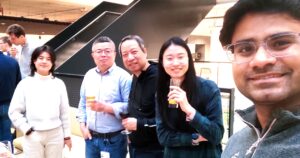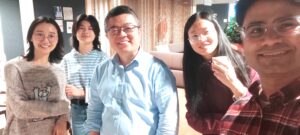Distributed computing can enhance the performance and usability of computational pathology applications.
In the last blog post, I described how computers could provide reliable cancer diagnostics by eliminating abnormalities from WSI. In this secondment, I learned about data-sharing techniques over the cloud and how distributed computing paradigms can be used for medical data.
Distributed computing can play a crucial role in the field of medical image analysis, especially in computational pathology, where the increasing volume of very large medical images encourages the need for faster and more accurate analysis is a valuable tool. This is particularly important in the field of pathology, where the analysis of large and complex images can be both time-consuming and resource-intensive. By leveraging the power of distributed computing, computational pathology (CPATH) can provide more detailed and accurate diagnoses by refining the Whole Slide Image (WSI) from artifacts and using it for diagnostic algorithms later, ultimately leading to reliable predictions. For example, in the case of cancer diagnosis, distributed computing can be used to analyze large amounts of medical images over the cloud, allowing reliable and more accurate diagnoses and treatment plans. This can lead to an efficient CPATH system in the form of a great assistive tool in clinical practice.
Processing WSIs over the cloud provides many other advantages, including sharing anonymized data and content-based image retrieval. Anonymization is essential in medical data when sharing is required. WSIs, available over the cloud, can be easily shared with other healthcare professionals and institutions, improving collaboration and reducing the risk of errors. Content-based image retrieval is another crucial aspect of medical image analysis. With the help of cloud computing, it can be done more efficiently. The cloud provides a centralized repository for medical images, allowing faster and more accurate retrieval of images based on their content. Moreover, the cloud offers a scalable infrastructure that can be easily expanded as needed, which is essential in medical image analysis, where the volume of data or required services continues to grow.
I was a part of the Multiscale Networked Systems (MNS) group during my research stay, where I met researchers across different computing domains. I was able to learn about the latest trends and advancements in this field and understand the importance of cloud computing in the modern world. The secondment provided an opportunity to learn from various aspects of cloud computing, including the architecture of cloud systems, security, and privacy issues, and the use of cloud services for big data processing. The research environment was engaging, and the secondment was enriched to get hands-on learning and collaboration. One of the important highlights from this secondment is the ongoing collaboration with ESR2, where we planned to scale preprocessing service over the cloud.
Aside from academics, I was fortunate to have this unforgettable experience of being in Amsterdam. Living in a different city not only broadens one’s perspective but also provides a unique opportunity to immerse in a new culture, make new friends, and expand one’s knowledge. Amsterdam is a fantastic city. From the beautiful canals and historic buildings to the museums, cafes, and nightlife, there was always something to do and see.
Thanks to Prof. Zhiming Zhao for providing opportunities to interact and learn from individuals in the MNS group.
Participating in the social gathering at Informatic Institute, University of Amsterdam. From left to right ESR1 (Na Li), Dr. Zhao, Prof. Rong, ESR2 (Yuandou Wang), and myself.
Dr. Zhiming Zhao hosted a nice farewell in the last week of my secondment. It was a time well spent towards research and extra-curricular activities.
In my next blog post, I’ll keep you updated on the publication of the results from this collaboration. Till then, stay tuned!
Neel Kanwal – ESR4



